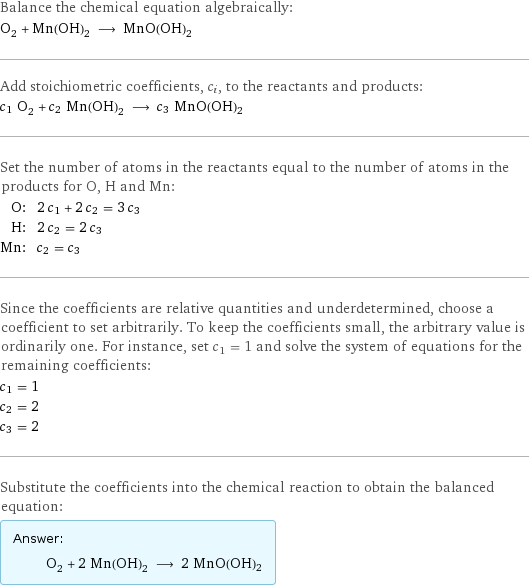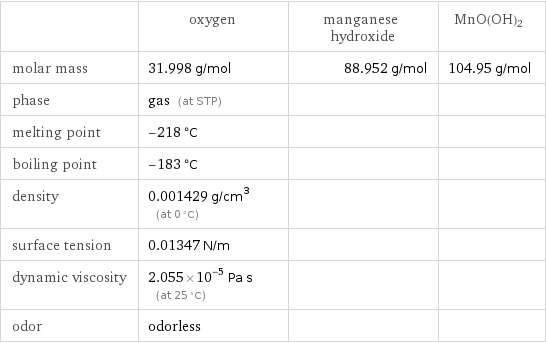Input interpretation

O_2 oxygen + Mn(OH)_2 manganese hydroxide ⟶ MnO(OH)2
Balanced equation

Balance the chemical equation algebraically: O_2 + Mn(OH)_2 ⟶ MnO(OH)2 Add stoichiometric coefficients, c_i, to the reactants and products: c_1 O_2 + c_2 Mn(OH)_2 ⟶ c_3 MnO(OH)2 Set the number of atoms in the reactants equal to the number of atoms in the products for O, H and Mn: O: | 2 c_1 + 2 c_2 = 3 c_3 H: | 2 c_2 = 2 c_3 Mn: | c_2 = c_3 Since the coefficients are relative quantities and underdetermined, choose a coefficient to set arbitrarily. To keep the coefficients small, the arbitrary value is ordinarily one. For instance, set c_1 = 1 and solve the system of equations for the remaining coefficients: c_1 = 1 c_2 = 2 c_3 = 2 Substitute the coefficients into the chemical reaction to obtain the balanced equation: Answer: | | O_2 + 2 Mn(OH)_2 ⟶ 2 MnO(OH)2
Structures

+ ⟶ MnO(OH)2
Names

oxygen + manganese hydroxide ⟶ MnO(OH)2
Equilibrium constant
![Construct the equilibrium constant, K, expression for: O_2 + Mn(OH)_2 ⟶ MnO(OH)2 Plan: • Balance the chemical equation. • Determine the stoichiometric numbers. • Assemble the activity expression for each chemical species. • Use the activity expressions to build the equilibrium constant expression. Write the balanced chemical equation: O_2 + 2 Mn(OH)_2 ⟶ 2 MnO(OH)2 Assign stoichiometric numbers, ν_i, using the stoichiometric coefficients, c_i, from the balanced chemical equation in the following manner: ν_i = -c_i for reactants and ν_i = c_i for products: chemical species | c_i | ν_i O_2 | 1 | -1 Mn(OH)_2 | 2 | -2 MnO(OH)2 | 2 | 2 Assemble the activity expressions accounting for the state of matter and ν_i: chemical species | c_i | ν_i | activity expression O_2 | 1 | -1 | ([O2])^(-1) Mn(OH)_2 | 2 | -2 | ([Mn(OH)2])^(-2) MnO(OH)2 | 2 | 2 | ([MnO(OH)2])^2 The equilibrium constant symbol in the concentration basis is: K_c Mulitply the activity expressions to arrive at the K_c expression: Answer: | | K_c = ([O2])^(-1) ([Mn(OH)2])^(-2) ([MnO(OH)2])^2 = ([MnO(OH)2])^2/([O2] ([Mn(OH)2])^2)](../image_source/778f5354524e8f80234a66aac8a43f70.png)
Construct the equilibrium constant, K, expression for: O_2 + Mn(OH)_2 ⟶ MnO(OH)2 Plan: • Balance the chemical equation. • Determine the stoichiometric numbers. • Assemble the activity expression for each chemical species. • Use the activity expressions to build the equilibrium constant expression. Write the balanced chemical equation: O_2 + 2 Mn(OH)_2 ⟶ 2 MnO(OH)2 Assign stoichiometric numbers, ν_i, using the stoichiometric coefficients, c_i, from the balanced chemical equation in the following manner: ν_i = -c_i for reactants and ν_i = c_i for products: chemical species | c_i | ν_i O_2 | 1 | -1 Mn(OH)_2 | 2 | -2 MnO(OH)2 | 2 | 2 Assemble the activity expressions accounting for the state of matter and ν_i: chemical species | c_i | ν_i | activity expression O_2 | 1 | -1 | ([O2])^(-1) Mn(OH)_2 | 2 | -2 | ([Mn(OH)2])^(-2) MnO(OH)2 | 2 | 2 | ([MnO(OH)2])^2 The equilibrium constant symbol in the concentration basis is: K_c Mulitply the activity expressions to arrive at the K_c expression: Answer: | | K_c = ([O2])^(-1) ([Mn(OH)2])^(-2) ([MnO(OH)2])^2 = ([MnO(OH)2])^2/([O2] ([Mn(OH)2])^2)
Rate of reaction
![Construct the rate of reaction expression for: O_2 + Mn(OH)_2 ⟶ MnO(OH)2 Plan: • Balance the chemical equation. • Determine the stoichiometric numbers. • Assemble the rate term for each chemical species. • Write the rate of reaction expression. Write the balanced chemical equation: O_2 + 2 Mn(OH)_2 ⟶ 2 MnO(OH)2 Assign stoichiometric numbers, ν_i, using the stoichiometric coefficients, c_i, from the balanced chemical equation in the following manner: ν_i = -c_i for reactants and ν_i = c_i for products: chemical species | c_i | ν_i O_2 | 1 | -1 Mn(OH)_2 | 2 | -2 MnO(OH)2 | 2 | 2 The rate term for each chemical species, B_i, is 1/ν_i(Δ[B_i])/(Δt) where [B_i] is the amount concentration and t is time: chemical species | c_i | ν_i | rate term O_2 | 1 | -1 | -(Δ[O2])/(Δt) Mn(OH)_2 | 2 | -2 | -1/2 (Δ[Mn(OH)2])/(Δt) MnO(OH)2 | 2 | 2 | 1/2 (Δ[MnO(OH)2])/(Δt) (for infinitesimal rate of change, replace Δ with d) Set the rate terms equal to each other to arrive at the rate expression: Answer: | | rate = -(Δ[O2])/(Δt) = -1/2 (Δ[Mn(OH)2])/(Δt) = 1/2 (Δ[MnO(OH)2])/(Δt) (assuming constant volume and no accumulation of intermediates or side products)](../image_source/cd3786f9fb7a356612ee5b831850f51e.png)
Construct the rate of reaction expression for: O_2 + Mn(OH)_2 ⟶ MnO(OH)2 Plan: • Balance the chemical equation. • Determine the stoichiometric numbers. • Assemble the rate term for each chemical species. • Write the rate of reaction expression. Write the balanced chemical equation: O_2 + 2 Mn(OH)_2 ⟶ 2 MnO(OH)2 Assign stoichiometric numbers, ν_i, using the stoichiometric coefficients, c_i, from the balanced chemical equation in the following manner: ν_i = -c_i for reactants and ν_i = c_i for products: chemical species | c_i | ν_i O_2 | 1 | -1 Mn(OH)_2 | 2 | -2 MnO(OH)2 | 2 | 2 The rate term for each chemical species, B_i, is 1/ν_i(Δ[B_i])/(Δt) where [B_i] is the amount concentration and t is time: chemical species | c_i | ν_i | rate term O_2 | 1 | -1 | -(Δ[O2])/(Δt) Mn(OH)_2 | 2 | -2 | -1/2 (Δ[Mn(OH)2])/(Δt) MnO(OH)2 | 2 | 2 | 1/2 (Δ[MnO(OH)2])/(Δt) (for infinitesimal rate of change, replace Δ with d) Set the rate terms equal to each other to arrive at the rate expression: Answer: | | rate = -(Δ[O2])/(Δt) = -1/2 (Δ[Mn(OH)2])/(Δt) = 1/2 (Δ[MnO(OH)2])/(Δt) (assuming constant volume and no accumulation of intermediates or side products)
Chemical names and formulas

| oxygen | manganese hydroxide | MnO(OH)2 formula | O_2 | Mn(OH)_2 | MnO(OH)2 Hill formula | O_2 | H_2MnO_2 | H2MnO3 name | oxygen | manganese hydroxide | IUPAC name | molecular oxygen | manganous dihydroxide |
Substance properties

| oxygen | manganese hydroxide | MnO(OH)2 molar mass | 31.998 g/mol | 88.952 g/mol | 104.95 g/mol phase | gas (at STP) | | melting point | -218 °C | | boiling point | -183 °C | | density | 0.001429 g/cm^3 (at 0 °C) | | surface tension | 0.01347 N/m | | dynamic viscosity | 2.055×10^-5 Pa s (at 25 °C) | | odor | odorless | |
Units
